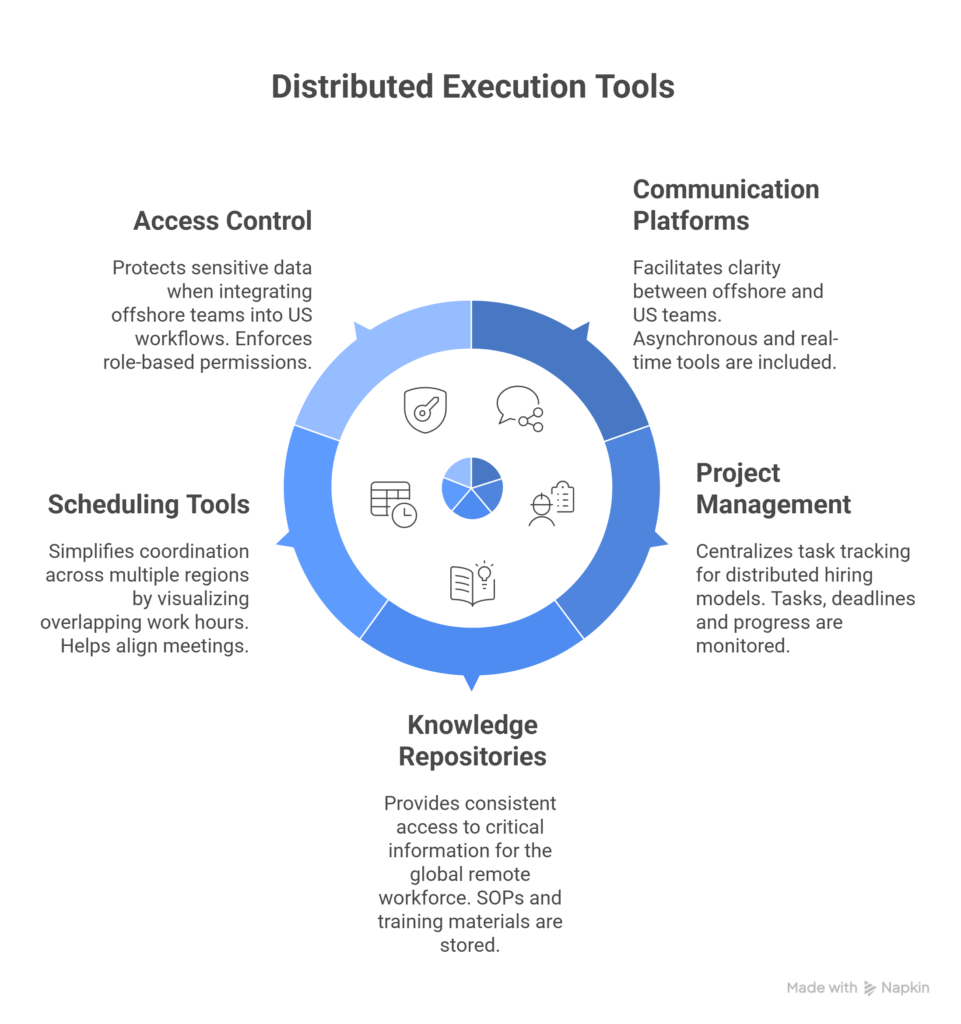Managing offshore teams requires efficient tools to bridge time zones, streamline communication, and maintain productivity. Remote collaboration tools have become essential for businesses relying on global talent, offering solutions that simplify project management, file sharing, and real-time interaction. These platforms ensure your team stays connected and aligned no matter where they are.
From video conferencing software to task management systems, the right tools can improve workflow and reduce delays caused by miscommunication. Choosing effective solutions tailored to your team’s needs is critical for achieving seamless collaboration across borders.
Are you ready to explore how these tools can transform the way your offshore team works?
Core Tool Categories to Enable Distributed Execution
Efficient remote collaboration tools are essential for managing offshore teams and ensuring seamless distributed execution. These tools address communication gaps, streamline workflows, and enhance team productivity across time zones.

Communication Platforms: Async and Real-Time
Communication platforms ensure clarity between offshore employees and US-based teams. Asynchronous tools like Slack or Microsoft Teams allow messages without requiring immediate responses, ideal for low-overlap time zones. Real-time options such as Zoom or Google Meet help instant discussions for urgent matters or project alignment meetings.
Combining both methods reduces delays in decision-making while accommodating global workforce schedules.
Project Management and Workflow Coordination
Project management systems centralize task tracking for distributed hiring models. Tools like Trello or Asana enable you to assign tasks, set deadlines, and monitor progress transparently. Offshore staffing benefits from these platforms by reducing miscommunication during cross-border recruitment processes.
Integrated workflow automation ensures that repetitive tasks don’t hinder operational efficiency when scaling with offshore professionals.
Knowledge Sharing and Documentation Repositories
Knowledge repositories provide consistent access to critical information for your global remote workforce. Platforms like Confluence or Notion store SOPs, training materials, and project documentation securely.
Offshore hires can quickly onboard through structured resources, avoiding bottlenecks caused by limited knowledge transfer in international team expansion efforts.
Time Zone Visibility and Scheduling Tools
Scheduling tools simplify coordination across multiple regions by visualizing overlapping work hours within distributed workforce operations. Calendly or World Time Buddy helps align meetings with minimal disruption to offshore team performance tracking. For hiring talent across time zones, these tools optimize availability planning without compromising productivity.
Access Control and Security-First Collaboration
Access control systems protect sensitive data when integrating offshore teams into US workflows. Solutions like Okta or LastPass enforce role-based permissions while maintaining compliance with cross-border recruitment standards.
Secure collaboration frameworks prevent unauthorized access during onboarding remote global talent into core functions of your business operations.
Top Remote Collaboration Tools by Function
Selecting the right tools ensures seamless collaboration for offshore teams. Below is a breakdown of top tools categorized by their functions, helping you optimize workflows across engineering, marketing, and sales departments.
Tools for Offshore Engineering Teams
GitHub
GitHub simplifies version control and code management for distributed engineering teams. It enables real-time collaboration on repositories, ensuring consistency when hiring offshore developers or managing remote-first projects.
Linear
Linear enhances task tracking with an intuitive interface designed for agile development. It’s ideal for managing distributed engineering teams working across time zones.
Jira
Jira supports complex project tracking with customizable workflows. Offshore team performance tracking becomes more efficient through its detailed reporting features.
Docker
Docker standardizes application deployment in diverse environments. This tool is critical when integrating global delivery teams into US operations or scaling with offshore professionals.
Notion
Notion combines documentation and project management, making it easier to onboard remote engineers and share knowledge across borders efficiently.
Tools for Offshore Marketing Teams
Asana
Asana streamlines campaign planning and execution for international marketing efforts. Offshore recruitment for marketing teams benefits from its centralized task assignment system.
Trello
Trello organizes content calendars visually, improving coordination among cross-border marketing hires. Its simplicity suits both small-scale tasks and large campaigns.
Slack
Slack fosters instant communication within globally dispersed marketing teams. Use it to maintain alignment during multi-region talent acquisition initiatives.
Figma
Figma allows collaborative design work in real time, crucial for creative processes involving offshore staffing models in core departments like branding or UX/UI design.
Loom
Loom facilitates asynchronous video updates, reducing miscommunication during onboarding remote global talent or coordinating feedback loops across regions.
Tools for Offshore Sales Teams
HubSpot
HubSpot integrates CRM functionalities that streamline lead tracking and client engagement. Hiring international sales talent becomes scalable with its automation capabilities tailored to global markets.
Salesforce
Salesforce offers enterprise-grade solutions for managing pipelines across continents. It aligns well with operational hiring across multiple regions due to its robust analytics tools.
Slack
Slack accelerates internal communication between distributed sales representatives and managers handling accounts in different time zones globally.
Gong
Gong analyzes sales calls using AI insights, providing actionable data to improve closing rates when building borderless hiring pipelines for your sales force.
Google Workspace
Google Workspace centralizes document sharing and email communications essential for aligning strategies while recruiting internationally for remote roles in sales operations.

Tool Selection Criteria for Offshore Use
Selecting the right tools for offshore teams ensures productivity and seamless collaboration. Evaluate each tool against specific criteria to address challenges like time zone differences, language barriers, onboarding speed, and data security.
Works Seamlessly Across Time Zones
Tools must help asynchronous communication and scheduling across regions. Features like shared calendars, automatic time zone adjustments, and meeting availability indicators are essential. For example, platforms with built-in time zone conversion simplify coordination when hiring talent across multiple regions or managing distributed engineering teams.
Consider whether the tool supports low-overlap working hours by enabling task updates without requiring real-time interaction. This is critical for maintaining operational efficiency in a global workforce planning model or while scaling operations with remote hiring.
Supports English-First, Multiregional Teams
Ensure tools prioritize English as the default language while offering multilingual support if needed. Offshore staffing often involves team members from emerging talent markets where English proficiency varies. Tools should include features like spell-checkers, translation options, or simplified interfaces to reduce miscommunication risks during cross-border recruitment workflows.
For instance, clear documentation templates and standardized terminology help align international hires with US-based processes. This consistency strengthens your distributed workforce operations by minimizing errors caused by linguistic misunderstandings.
Enables Fast Onboarding and Low Friction Adoption
Adopt tools that require minimal training and integrate easily into existing workflows. User-friendly dashboards, pre-built templates, and guided tutorials accelerate onboarding for offshore professionals hired through international labor market access initiatives.
Fast adoption reduces downtime during integration phases of long-term offshore employment models or when scaling global teams efficiently. Prioritize solutions that streamline cross-border onboarding processes to ensure new hires contribute quickly without delays caused by complex setups.
Integrates With Your Core Tech Stack
Choose tools compatible with your current systems to avoid disruptions in workflow continuity. For example, project management software should sync seamlessly with communication platforms used for recruiting internationally for remote roles or managing distributed engineering teams.
Integration capabilities also matter when building borderless hiring pipelines or operationalizing cross-border hiring strategies at scale. Look for APIs or native integrations that enable smooth data exchange between HR systems, collaboration tools, and performance tracking platforms.
Built-In Access Control for Data Security and IP
Data protection is non-negotiable when managing international hires or sourcing remote professionals globally. Tools must offer enterprise-grade access control features such as role-based permissions, two-factor authentication (2FA), and audit logs to safeguard sensitive information related to offshore team lifecycle management.
This is particularly important when integrating offshore teams into US workflows where compliance-aligned international hiring standards apply. Secure access controls protect intellectual property (IP) while ensuring regulatory adherence during multi-region talent acquisition efforts aimed at scaling global delivery functions effectively.
Mistakes to Avoid When Equipping Global Teams
Relying on US-Centric Tools Without Time Zone Flexibility
Using tools designed for a single time zone limits offshore team efficiency. Many US-centric platforms lack features like automatic time zone adjustments or scheduling flexibility, which are critical when managing distributed teams across regions. For example, tools without shared calendar integrations or real-time updates can delay project timelines and disrupt workflows.
Evaluate software compatibility with global workforce planning needs before implementation. Look for solutions that support hiring talent across time zones and enable seamless collaboration regardless of location. This ensures smoother operations and minimizes delays caused by misaligned schedules.
Overlapping Tool Functions That Create Noise
Deploying multiple tools with redundant functions confuses offshore employees and reduces productivity. For instance, using two task management systems simultaneously creates duplicate workstreams and complicates tracking progress. Offshore staffing models thrive on clarity, not complexity.
Streamline your remote team infrastructure by consolidating overlapping functionalities into fewer platforms. Choose scalable tools that integrate well with existing workflows while supporting long-term offshore staffing goals. Simplified processes lead to better focus and improved outcomes for distributed teams.
Ignoring Onboarding and Usage Standards
Skipping standardized onboarding leads to inconsistent tool usage among international hires. Without clear guidelines, some employees may underutilize essential features, resulting in inefficiencies during cross-border recruitment compliance efforts or global delivery functions.
Establish consistent processes for international hires by documenting best practices for each platform used within your organization. Provide step-by-step guides tailored to the specific roles of offshore professionals, ensuring they align with operational expectations from day one.
Skipping Tool Training for Offshore Hires
Assuming new hires will adapt quickly without training undermines their performance potential. Offshore recruitment often involves diverse backgrounds where familiarity with certain tools varies widely. A lack of structured training increases errors and slows integration into distributed workforce operations.
Offer role-specific training sessions focused on core platforms relevant to their tasks—whether it’s project management software for hiring offshore developers or CRM systems for hiring international sales pros. Regularly update training materials as workflows evolve to maintain high standards across your global remote workforce.
The Best Collaboration Stack Supports Output, Not Just Communication
Equipping your offshore teams with the right tools isn’t just about improving communication—it’s about driving results. By selecting solutions tailored to your team’s specific needs and workflows, you create an environment where productivity thrives across time zones.
Focus on tools that integrate seamlessly into existing processes, support diverse languages, and prioritize ease of use. When combined with proper onboarding and training, these tools empower your global workforce to collaborate effectively while avoiding common inefficiencies.
A well-chosen collaboration stack doesn’t just connect people; it aligns them toward shared goals, ensuring every effort contributes meaningfully to your organization’s success.

Frequently Asked Questions
What are the key tools for managing offshore teams effectively?
Efficient management of offshore teams requires tools like video conferencing software (Zoom, Google Meet), task management systems (Trello, Asana), communication platforms (Slack, Microsoft Teams), and knowledge-sharing tools (Confluence, Notion). Additionally, time zone coordination tools like Calendly and World Time Buddy are essential for scheduling across regions.
Why is time zone visibility important in remote collaboration?
Time zone visibility ensures seamless scheduling of meetings and reduces delays in decision-making. Tools like World Time Buddy or shared calendars with automatic time zone adjustments help coordinate tasks efficiently across global teams.
How can project management tools improve offshore team productivity?
Project management tools like Trello and Asana centralize task tracking, enhance transparency, and streamline workflows. They allow all team members to stay updated on progress, deadlines, and responsibilities regardless of location.
What features should I look for when selecting remote collaboration tools?
Look for user-friendly interfaces, multilingual support, integration with existing tech stacks, fast onboarding capabilities, time zone flexibility, and built-in access control features to ensure security and compliance.
Which tools are best suited for engineering teams working remotely?
Engineering teams benefit from GitHub (version control), Jira or Linear (task tracking), Docker (development environment setup), and Notion (knowledge sharing). These tools optimize coding workflows while enabling effective collaboration.
How do marketing teams benefit from remote collaboration tools?
Marketing teams use Asana or Trello for campaign planning, Figma for design collaboration, Slack for communication, Loom for asynchronous updates, and other platforms to organize content creation efficiently across distributed teams.
What are some recommended sales-focused remote collaboration tools?
Sales teams thrive using HubSpot or Salesforce for client engagement and pipeline management. Slack enhances internal communication while Gong provides insights into sales calls. Google Workspace simplifies document sharing globally.
Why is it important to avoid US-centric tools when managing offshore teams?
US-centric tools often lack features like flexible time zones or multilingual support that cater to global workforce needs. Using such tools may hinder efficiency by creating barriers in communication or workflow alignment.
How can organizations ensure consistent tool usage among offshore hires?
Standardized onboarding processes combined with role-specific training ensure consistent tool adoption. Clear guidelines on tool usage help integrate new hires seamlessly into existing workflows while minimizing confusion.
What common mistakes should be avoided when equipping global remote teams?
Avoid relying on overlapping or redundant tools that create confusion. Ensure selected software supports global needs like time zone flexibility. Neglecting proper onboarding or failing to evaluate compatibility with existing systems can also reduce productivity.




